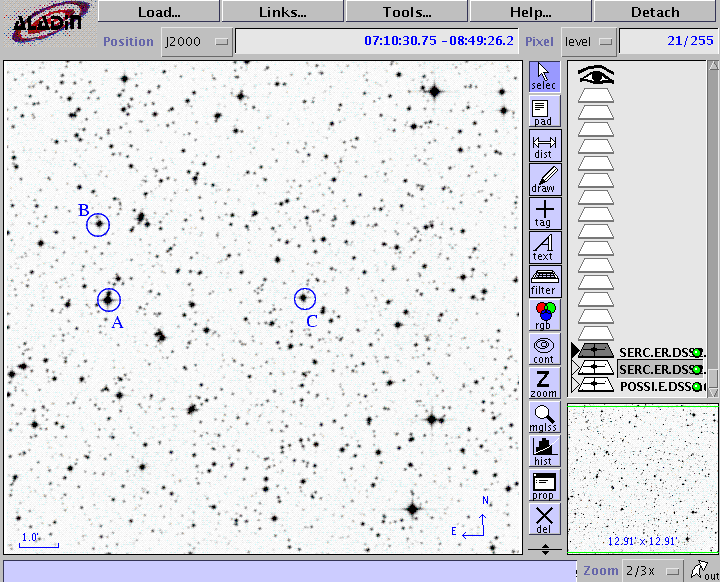
On the night of Mar 15/16, 2005 EST, I used the RIT Observatory's 12-inch Meade telescope and SBIG ST8 CCD camera to capture a series of images of the asteroid (30825) = 1990TG1. My colleagues Larry Marschall of the Gettysburg College Observatory and Vivian Hoette of Yerkes Observatory were also observing the asteroid tonight. Our plan was to take simultaneous images, so that we might calculate the parallax of the asteroid and hence its distance.
The plan:
Notes from the night
Here's a chart of the field through which the asteroid was scheduled to pass. The chart is about 13 arcminutes wide.

The asteroid should have been in the middle of this field at about 02:00 UT, and move about 1/3 of the field in the next hour.
Here's a copy of the first image I took, at midexposure UT 02:02:00.
If you look closely in the area just above star "C", you should see the asteroid.
I reduced the frames in the usual way: subtracting a median dark frame, and dividing by a flatfield. My attempts to take a dome flat failed (because I left the "dark image" box checked while acquiring them -- sigh), so I was forced to make a night-sky flat from the 11 images of the asteroid field. Fortunately, the telescope drifted a short distance between each exposure, so a median of all the images looked reasonably clean of residual stars. I used a blurry mask to get rid of any small-scale noise remaining and create the master flatfield frame.
I then measured the position and magnitude of about 100 stars in each frame. I used the match package to compare the detected objects to the USNO-B1.0 catalog; I picked stars from the catalog
I derive the following positions for the asteroid:
# Measurements of 1990TG1 from RIT Obs, UT 2005 March 16 # All images 10 seconds long. # UT of # mid-exposure RA (J2000) Dec <- ignore these values -> #---------------------------------------------------------------- 1 02:02:00 47 107.60814 -8.79976 1333 10.50 15.715 0.067 0 3 02:06:00 60 107.60348 -8.79896 1008 8.85 15.694 0.058 0 4 02:08:01 52 107.60114 -8.79853 1057 9.54 15.825 0.067 0 5 02:10:01 41 107.59891 -8.79808 1000 8.39 15.719 0.059 0 6 02:12:00 56 107.59660 -8.79769 1032 8.16 15.772 0.063 0 8 02:26:00 39 107.58026 -8.79489 1208 8.79 16.040 0.086 0 9 02:28:00 47 107.57784 -8.79452 1107 8.64 15.821 0.068 0 10 02:30:00 50 107.57565 -8.79402 1086 9.12 15.792 0.066 0
I sent these positions to the Minor Planet Center after formatting them in the official manner:
COD 920 CON M. Richmond, Physics Dept., RIT, Rochester, NY 14623 CON [mwrsps@rit.edu] OBS M. Richmond MEA M. Richmond TEL 0.25-m f/10 Schmidt-Cassegrain + CCD NET USNO-B1.0 ACK measurements of 1990TG1 30825 C2005 03 16.08472 07 10 25.95 -08 47 59.1 920 30825 C2005 03 16.08750 07 10 24.84 -08 47 56.3 920 30825 C2005 03 16.08890 07 10 24.27 -08 47 54.7 920 30825 C2005 03 16.09029 07 10 23.74 -08 47 53.1 920 30825 C2005 03 16.09167 07 10 23.18 -08 47 51.7 920 30825 C2005 03 16.10139 07 10 19.26 -08 47 41.6 920 30825 C2005 03 16.10278 07 10 18.68 -08 47 40.3 920 30825 C2005 03 16.10417 07 10 18.16 -08 47 38.5 920
In the near future, I hope to compare our positions from Rochester with those from Gettysburg and Yerkes to derive the parallax shift and hence the distance to the asteroid.
Last modified 3/18/2005 by MWR.